This post may contain affiliate links. This just means I may receive a small commission at no extra cost to you for helping them promote their product or service. I don’t endorse any services I don’t personally use or recommend.
There is no better adventure than exploring a country on a motorbike. But some countries are better suited to it than others. Vietnam is one of the best. On this North Vietnam motorbike loop, you’ll ride through small villages and explore the rural countryside that few travelers get to see. You’ll experience H’mong culture firsthand, not in a packaged tour. And you’ll stay in some of the most impressive homestays we’ve ever seen.
Disclaimer: Riding a motorbike without experience can be dangerous. Only you can decide if this mode of transport is right for you.
One More Thing: This guide is going to be long. There’s a lot of information you need before hitting the road and I want this to be your one-stop-shop before you start your adventure.

How to know this is the “RIGHT” Motorbike Route for You?
This guide is going to be VERY different from any of “3-week Vietnam itinerary” you’ll find online. We skipped all the touristy crap. Even if it’s the most popular thing to do in the country. Every single 20-something backpacker visits Ho Chi Minh City, Danang, Nha Trang, Hoi An, Hue, Hanoi, Ha Long Bay, Sa Pa, and Ha Giang and calls it a day. They do organized group tours. And they wonder why they don’t love Vietnam more. Why it feels so commercial and why everyone is trying to rip them off all the time?
The truth is these destinations have some good parts, that’s why they became so popular in the first place, but generally speaking, they have been soiled by years of mass tourism and cheesy re-enactments of “cultural” attractions. They have lost what originally made them so appealing.
This guide is going to instead focus on just the best parts of Northern Vietnam. You won’t visit all the places every blog online regurgitates and says you must-see— instead you’ll see incredible rural landscapes, stay in authentic H’mong homestays, eat freshly prepared meals, and see a side of Vietnam relatively untouched by decades of tourism. It’s a better experience, trust me.
I visited Vietnam & did all the basic tourist trail attractions back in 2016. And I’m not saying DON’T do *some* of them. If you have more time you should absolutely add Hoi An for its lovely architecture and exceptional food scene. You’ll just need to extend your visa and stay longer than 30 days in Vietnam.
This is just the good stuff. The stuff most people don’t know about and totally miss in Vietnam. I promise— if you’re the kind of person who likes off-the-beaten-path and hates being herded through attractions like cattle THIS is the Vietnam itinerary for you.
Important things to know before Motorbiking Vietnam
Now that we’ve established you’re in the right place…let’s talk about what you need to know. Motorbiking in Vietnam is a popular backpacker activity so most things are very straightforward but there are a few things that can be very helpful in getting you ahead of the learning curve.
Booking Homestays: While many can be booked on Booking.com (I’ve linked them), it’s much better for the property owner if you book in person. You probably won’t get a much cheaper price BUT the homestay owner will get ALL the profit instead of having to share with Booking.com. I recommend doing what we did and screenshotting the price of the room on Booking so you get the genius deal when you show up at the homestay to book in person. If you’re Motorbiking Vietnam in high season you may want to book ahead.
Safety While Motorbiking Vietnam
Let’s start with the obvious. Is motorbiking Vietnam safe? Vietnam has around 10,000 traffic deaths per year. A handful of those are tourists. While we were on the very popular Ha Giang motorbike loop a young woman died in a high-speed accident in the city center.
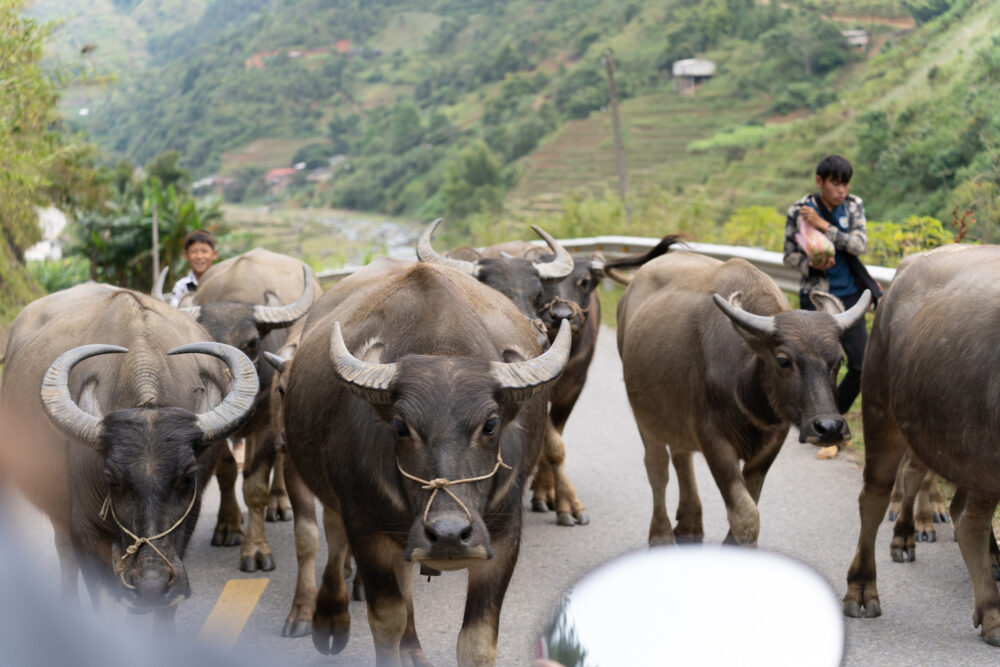
So no, driving in Vietnam isn’t super safe. This is not a place to learn how to ride a motorbike. But you don’t need to be an expert to navigate the local laws. Follow the flow of traffic, don’t speed, and PLEASE be on high alert for oncoming passing trucks. The roads in major cities (like Hanoi) are chaotic and you’ll want to get out of there ASAP. But main roads are often trucking routes. These can be equally as dangerous.
The good news is that most roads are well-paved and don’t have too many potholes. All the routes I suggest are good for traveling if you have any prior scooter/motorbike experience in Southeast Asia.
Do I Need An International Driver’s/Motorbike License: You don’t need an international driver’s license to rent a motorbike in Vietnam. Some retailers will ask for one now, because of the recent increase in tourist accidents but you won’t have a problem finding someone to rent from if you show up without one. Also, these aren’t officially valid in Vietnam anyways. If you get pulled over by police, technically, you need a Vietnamese motorbike license. I’ll explain later what to do if you run into the police on your journey.
If you have never tried motorbiking before Laos is a great place to try! The Thakhek loop in Laos is an easy 4-day ride and a great way to learn the basics before trying this longer Northern Vietnam motorbike loop.
Weather can make or break your journey. The northern half of Vietnam gets 3 distinct seasons. Cold winter, temperate shoulder seasons, and hot wet summer.
The most popular time for a North Vietnam motorbike loop is the hot summer months. But the best months are definitely the temperate shoulder seasons. Winter is supposed to be the clearest skies — which sounds good until you realize the mountain passes get FROST during this time. Like seriously cold. Be prepared for the cold if you try motorbiking Vietnam in winter.
May/June is, in my opinion, the best time to ride the north. It’s still relatively dry, not too hot, and not too cold. It’s also not a hugely popular time for domestic or international tourists so you won’t have to battle the crowds.
Another great option is September/October for nice weather and stunning rice fields. This is the most popular time for domestic travelers however SO you’ll have to share many of these places with lots of other people.
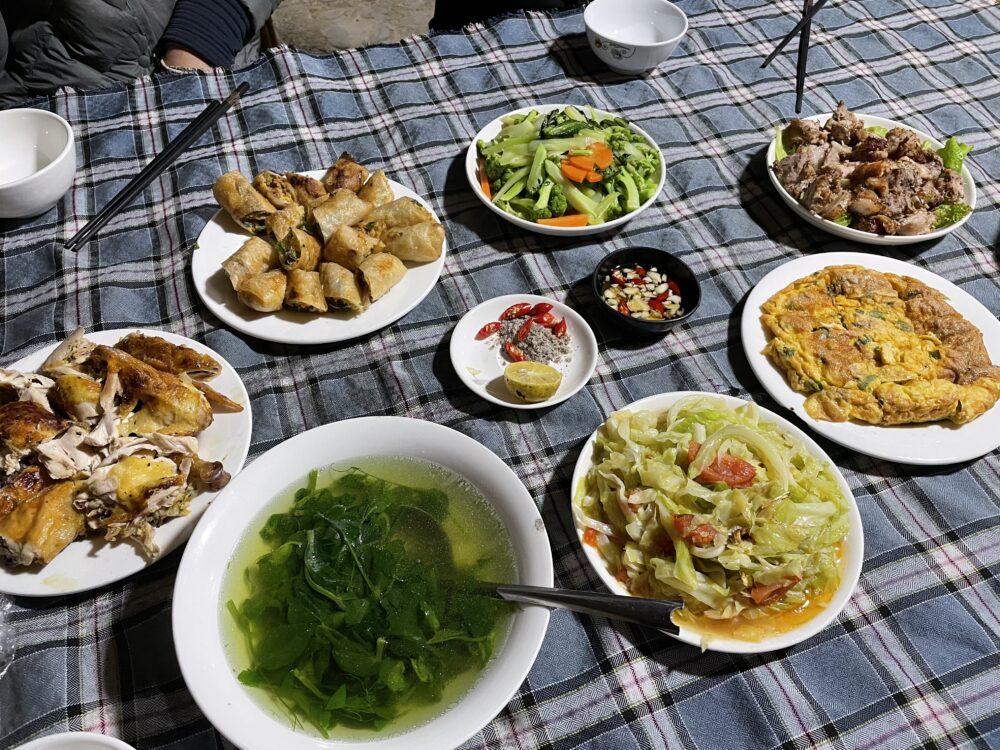

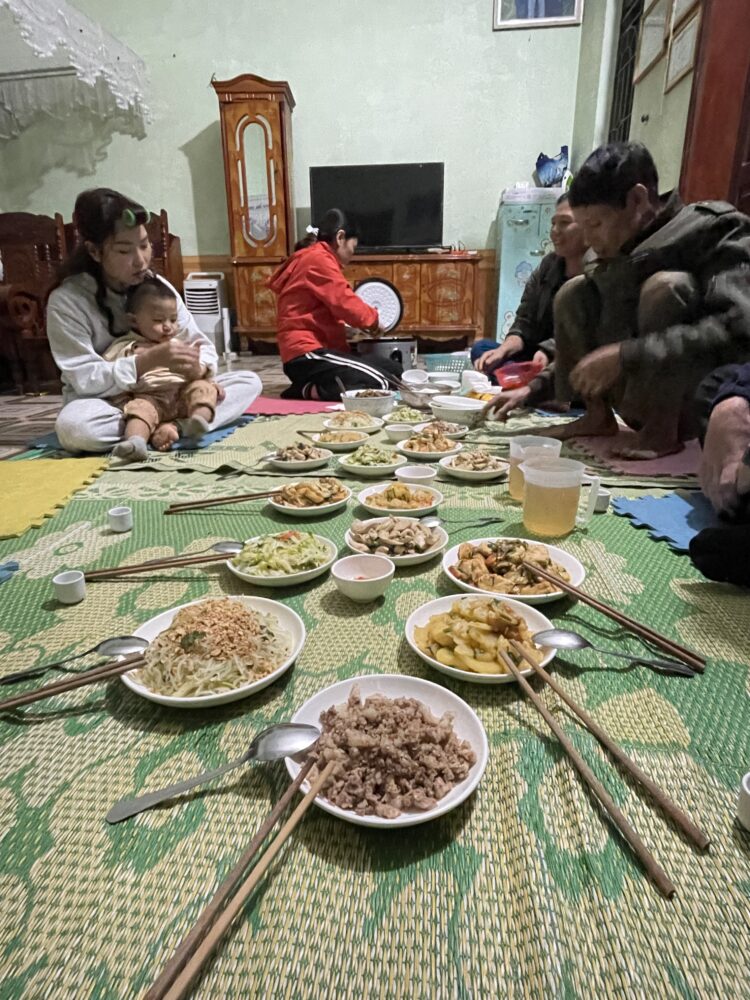
We rode the loop in winter. It was super doable and tons of fun, but very cold. Even colder when you’re in the wind on the back of the bike.
Hot tip: If it’s raining— don’t drive. This is your sign to stay in town another day. We were delayed by weather for 3 days in Tam Coc. Trust us, it’s never worth the added risks and discomfort of motorbiking Vietnam in the rain.
Which Motorbike is best?
What you’re really asking is what bike can handle the Quan Ba Pass if forced to ride the Ha Giang Loop in rain?
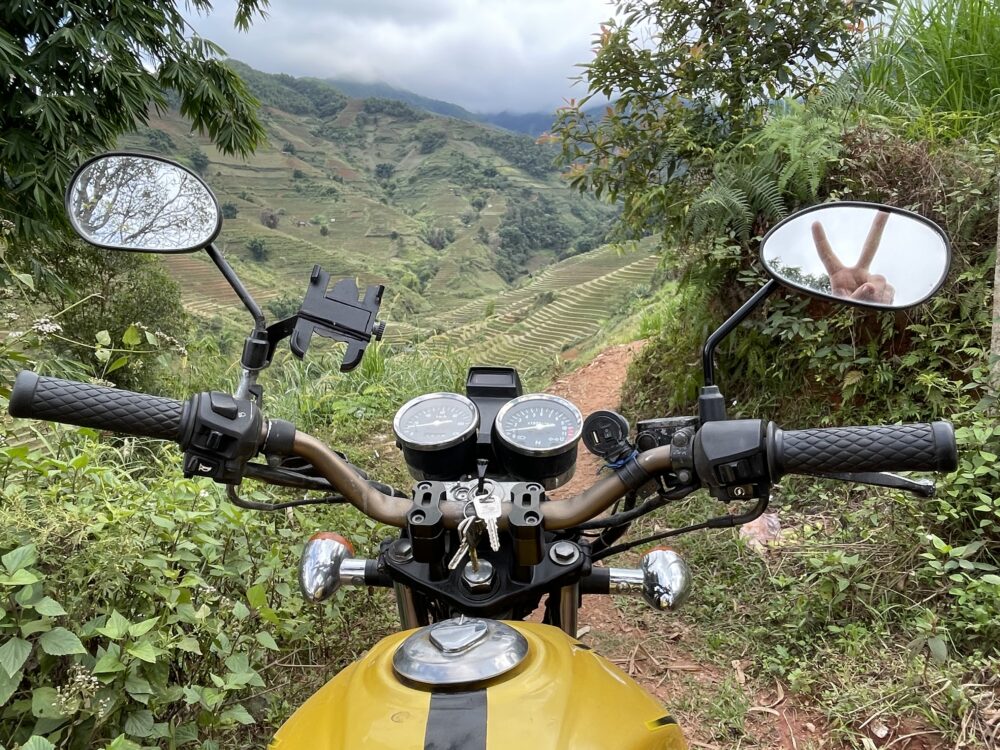
If you’re a couple (like us) the bigger the bike the better. You’re hauling twice the weight of a solo person. A manual 150cc is recommended.
The “Honda” Win is one of the most popular motorbikes in Vietnam because of the look. It’s just got that idealistic “motorbike-journey” look. They tend to break down. A lot. But they also are easy to repair because all mechanic shops are used to working with them since they are Vietnamese made. Not a great option but not the worst either. Just try to find one that’s relatively new. They have a short shelf life.
While the route is technically doable with a semi-automatic scooter (for one person) — I highly recommend getting at least a 125cc motorbike for the steep mountain passes (like Quan Ba Pass otherwise known as Heaven’s Gate). The lower gears will help keep your momentum uphill and give you more control while descending the steep roads.
Motorbike Rental Checklist: How Not to Rent a Lemon.
Whether you’re buying or renting, these are the things you should be sure to check before you commit to that particular bike.
- Great tires. Look for deep-treaded newish tires. This is the most important thing. When you ride the Ha Giang Loop up North you will need the traction.
- Newish brakes. Vitally important.
- A good bike rack. This is where you’ll strap your backpack for the journey. The rental place should provide you with bungees.
- Working blinkers and headlights.
- A high-quality helmet with a visor. The visor helps to conceal that you are not from here and can help you blend in a little when hiding from the police.
- A phone charging port and phone holder make GPS easy if you’re traveling alone. Not essential, but super handy.
Renting vs Buying a Motorbike in Vietnam
Renting or buying is totally up to you! You should expect to pay $8 or 200k Vietnamese per day for a manual 125cc motorbike. Less for a scooter, more for a larger motorcycle. If you plan to return the bike in a different city than you rented it in, it’s possible but you’ll have to pay a pretty penny. In this scenario, I think it’s usually preferred to buy.
You can usually purchase a bike for $400-$450. Make sure you get papers (official purchase docs known as the blue book) and do your research if you decide to buy. It’s easy to get scammed or ripped off with a junker of a bike.
Why we chose to rent: With only 30 days in the country we weren’t sure how easy it would be to sell the bike quickly. It made more financial sense to rent. And we didn’t really know what to look for in a bike. We had a lot of learning to do.

Our recommended route is for motorbike touring North of Hanoi. It starts and ends in Hanoi. This means you can rent your motorbike if you do not plan to embark on a quick visa run and extend your time in Vietnam.
What is a visa run? A visa run is a quick single-day border jump to get a fresh 30-day tourist visa in Vietnam. Right now, since they discontinued the “visa on arrival” you have to apply ahead of time at an embassy or online. The most popular places for quick visa runs are Cambodia and Laos.
How to Maintain your Motorbike
Once you have selected a bike you’ll have to do a few things while on the road to keep it going. Fortunately, There are mechanics everywhere. Even the smallest towns have small mechanic shops that can help you with any and all upkeep.
You’ll need to change your oil every 700 kilometers.
Around 3 times for this specific journey. It should cost around 70k Vietnamese or $3 each time if you go to the small shops. Twice that if you go to a large motorbike dealer. Try to avoid these.
Tire air fill-ups, greasing the chain, and other small maintenance jobs like topping off your brake fluid or tightening random loose bolts that fling about are 100% free! I always tried to give the mechanics a tip of $1 or so but many wouldn’t take it.
Breakdowns
There’s about a 100% chance you will have at least one unexpected breakdown. We had two on our first two days. In total, we ended up popping three tires and having the clutch cable snap once. We also crashed the bike once.
Fortunately, you will always, and I mean always, be within a short walk of a small mechanic shop. Just look for the “Xe May” sign. It’s crazy how many of them there are in the country, but I guess when you see the state of the roads and motorbikes…it does make sense.
Here’s a quick look at what repairs *should* cost but truth be told, when you’re venerable and have nowhere else to go…you kinda just gotta pay whatever they ask.
- Popped tire: 70k- 150k
- Quick Repair like clutch cable: 100k
- Chain repair/tighten: 100k
- Chain Oil: Free
The sign “Rue Xe” means motorbike wash. If things are looking a little muddy these will get you cleaned up.
Maps for your North Vietnam Motorbike Loop
I made a very detailed map below to guide you on your route. Everywhere from Hanoi to Ha Giang and Ha Giang to Cao Bang. Google Maps is definitely the most helpful map app for Vietnam and has “semi”-accurate drive times. Most days we doubled the drive time with all our stops, slow-going roads, and coffee breaks.
I do recommend getting a SIM card but make sure you get Viettel, not Vinaphone, as the service is way better. If you’re a purist though— you can totally do the route without one. Just download Maps.me and totally ignore the estimated drive times.
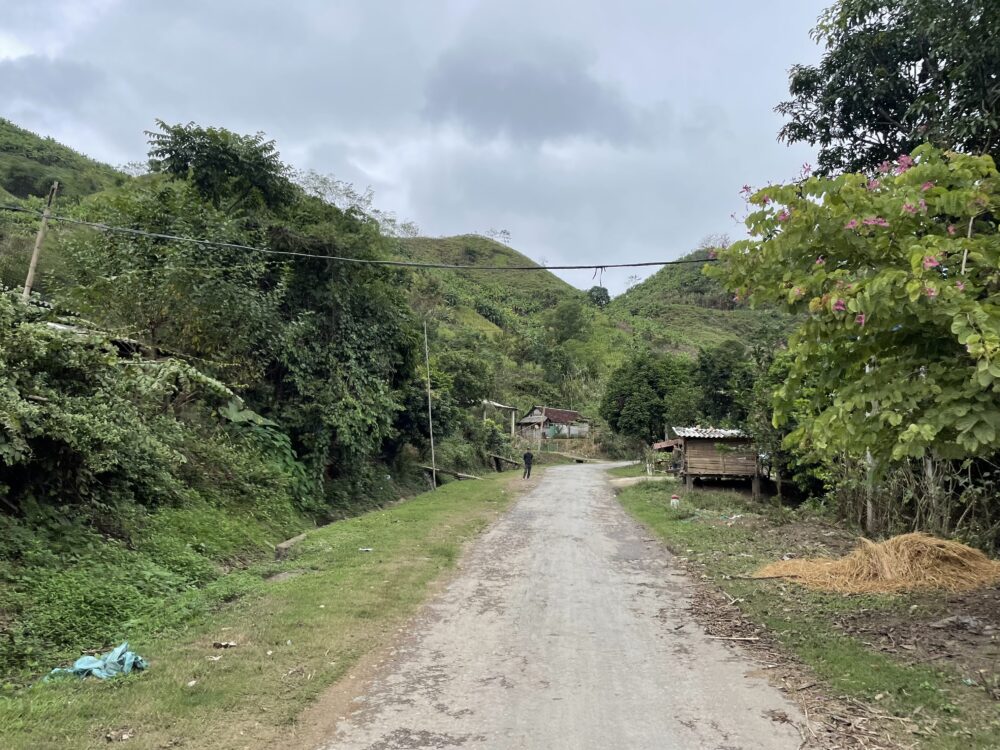
I recommend everyone download maps.me as a backup in case your service fails. (It will)
Our North Vietnam Motorbike route doesn’t recommend any drive day more than 200km. This is a super long drive on a motorbike. Especially on Vietnamese roads. You’ll also want to take photos and enjoy the ride which takes even longer.
Hot tip: Gas is very easy to find along the route. But you should try and top off your tank each day before you head out on a stretch over 100km just to be safe. The small stands in little towns sell petrol in glass bottles if you’re in a pinch. Just ask around.
REMEMBER! You can always quit at any time on the full three-week journey. This is because you can ride buses with a motorbike in Vietnam. This means that any time you’re faced with a “too-long-to-drive” stretch or short on time you can simply bus between destinations. It typically costs around the price of 2 tickets to ship your bike along the route and they store it underneath the bus.
Dealing with the Police
Bribes. Roads to avoid. Let’s dig into it. Technically, speaking tourists cannot ride motorbikes in Vietnam. But truthfully, even most Vietnamese don’t have a valid license. The police in Vietnam, thankfully, are corrupt and are really just pulling you over to extort some cash from you.
Here’s what you should do to pay the LEAST amount in bribes to the police.
1. Avoid route 1 like the plague.
My North Vietnam motorbike route does not take you on route 1 or any major trucking routes for that matter. This is because the police are all over them. You’re just asking to get stopped. And they aren’t scenic anyways.
2. Be aware of the Ha Giang and Mui Ne checkpoints.
Here the police have specific traps set up to fine tourists. My route won’t take you through Mui Ne (this is in Southern Vietnam) but in Ha Giang, I’ve marked the police stop on my map. These police stops change, however, so you should stay at Be’s Homestay where Dani and Thao can give you the full and most up-to-date run down on police in Ha Giang.
3. Put 200k in your wallet and store the rest in your bag.
It’s very difficult to negotiate if you have a lot of money on you. Be sure to put your bank card in your backpack as well, not in your wallet.
If you do get stopped…
Step 1: Grab your keys out of the ignition and put them in your pocket. The police will often snatch your keys to increase their bargaining power. And once they have the keys to your vehicle you’re essentially at their mercy.
Step 2: They will either ask for your license or say you were speeding. It all means the same thing. They want money.
Step 3: Insist you only have 200k in your wallet. Show them even. They will ask for 2 million, even 5 million, just keep holding out. If they ask you to go to an atm say you don’t have your bank card.
Step 4: Wait them out.
They want to make money. But time is also money in Vietnam, time they could spend scamming the next traveler. You might have to wait 15 or 30 minutes but eventually, they will take it and tell you to go.
If you have any international permit, even if it’s not for motorbikes or only up to 100cc you might as well act confident and show it to them. Most can’t read English and they love paperwork in Vietnam. It all feels very official and odds are they might believe you and let you off with a warning.
What to Pack for the North Vietnam Motorbike Loop

This is your comprehensive packing list for doing the motorbike loop through North Vietnam in winter or shoulder season when you will experience at least some cold weather. In summer, you can adjust this list by swapping one warm weather outfit for one of the cold.
- A pair of shorts and a tank top for warm days.
- Two pairs of pants that can be layered for the cold. You should ride with pants on for protection even in the summer.
- A poncho (full body if you can) for the inevitable rainy day.
- A sweatshirt and an outer layer puffy jacket for riding through the high passes. Your outer layer should be water-resistant at the least or you’ll be fully relying on your poncho.
- A cozy outfit for changing into at the homestays. If in summer, make it breezy. In winter, make it warm. You’ll want something dry and clean (ish) to change into when you arrive at your homestays.
- A rain shell for your backpack. You can also use a garbage back or poncho if your backpack doesn’t come with one.
- Always travel with a full liter water bottle just in case.
- Snacks are essential because in many places you’ll have a hard time finding lunch.
- Sunscreen. A must.
- Sunglasses.
- Cards for evenings with no wifi.
- Sandals + close-toed shoes for hiking and motorbiking.
- Two pairs of thick socks so you can keep your feet dry.
Hot Tip: Place a garbage bag or poncho underneath your backpack on the motorbike rack so the back tire doesn’t kick dirt, mud, and water all over the underside of it. We learned this the hard way.
It might sound like a lot of this is only pertinent to the cold/wet season but North Vietnam is colder and wetter year-round than the rest of the country. It’s good to be prepared for diverse weather in this region. That being said— pack light. The less weight on your bike the easier the ride will be.
Where will you keep the rest of your stuff?
Any hostel will likely hold your stuff for you in the luggage room. Tobalo Hostel in Hanoi was our favorite and they held our stuff for 3 weeks+ for free. I highly recommend staying with them during your time in Hanoi.
Our Three Week North Vietnam Motorbike Route
This could be a two-week route (with alterations) or a four-week route. It all depends on how long you decide to spend in each destination + if you want to skip anything. Because yes, it is about the journey but there are some towns that I highly recommend you stay more than one night in if you enjoy them.
Disclaimer: Again most motorbike travelers in Vietnam will run the country from end to end. But they won’t *really* see much beyond what a traveler riding the buses will. They are still sticking to the very developed and well-known tourist destinations and rushing to complete it all before their visa ends. 30 days is NOT a lot of time for the North. Not if you want to step away from the fast-paced tours and really see all the cool places Vietnam has to offer. And ask any traveler— Vietnam’s North is much prettier and more interesting than the South.
I’ll lay this route out by drive days. The rest is up to you.
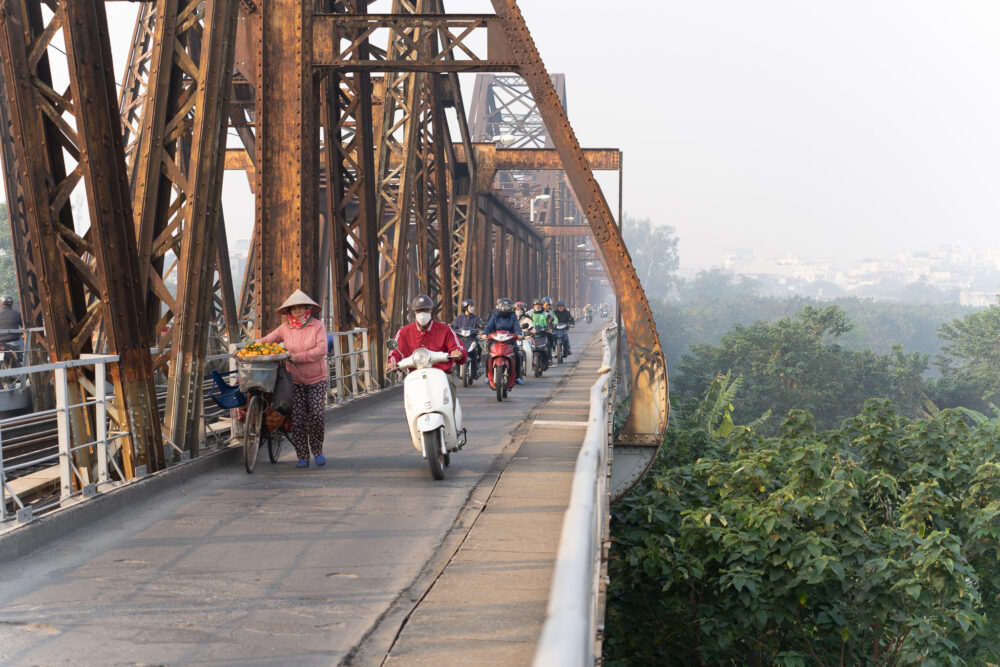
Drive Day One: Hanoi to Tam Coc (150 KM)
This is south of Hanoi. If you are not planning on making a loop that begins and ends in Hanoi, I suggest skipping this day and instead continuing on to day two instead. You can visit the Ninh Bihn region later.
Day one is one of the most technically challenging days of the loop simply because you have to drive in Hanoi city. Pure chaos. I highly recommend picking your motorbike up the night before so you can leave early in the morning with less traffic. Honestly, the earlier the better. 6 AM if you can.
Your GPS is going to direct you to take route 1 because it’s the fastest and most direct way to Tam Coc/Ninh Bihn. Don’t do that. There will be police checkpoints. Instead, follow the route we have laid out by putting in these 3 points to your Google Maps. The route is fairly boring since it covers many populated areas but becomes more impressive the closer you get to your destination.
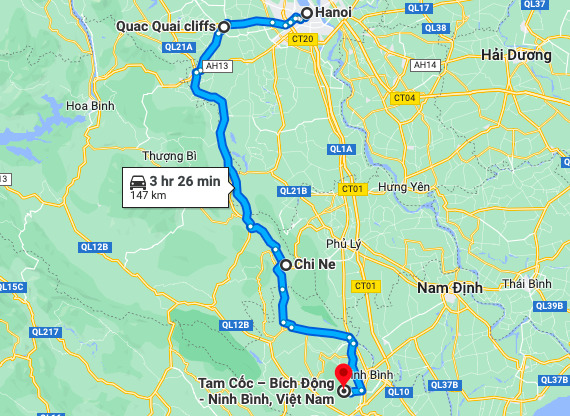
Estimated drive time: 5 hours
We chose Tam Coc instead of Ninh Bihn as a home base for the area because we heard it was more charming, closer to the attractions, and less touristy. But it’s all very touristy. It was a pretty little town and we really enjoyed the homestay. Expect your time in the Ninh Bihn area to be the most touristy on this route.
Recommend Homestay: Phi Hung’s Unique Homestay ($12.70 private room w/ breakfast)
The host here is such a character. She’s possibly the happiest person I’ve ever met. Enthusiastically greeting every guest and super helpful. She let us park the bike inside as well. The rooms are actually quite luxurious and have super comfy beds. Morning pancakes 10/10.
Length of Stay: 2 nights
The Ninh Bihn area has a lot to offer if you’re interested. There is the Mua Cave viewpoint (do it at sunrise NOT sunset for the fewest crowds), a handful of temples and pagodas, and boat rides through limestone caves in Thong La. I’ve marked the worthwhile attractions on the map at the end of this post.

Drive Day Two: Tam Coc to Pu Luong (130 KM)
The first half of this drive will be through populated towns and main roads. Always watch out for trucks passing head-on and keep to the far side. The second half, however, is winding and mountainous and beautiful. You’ll go through some stunning scenery and small villages along the way. The final leg into Pu Luong is quite difficult unless you take the lower road route. I marked both routes to the homestay on the map below.
The longer “lower” route doesn’t require you to go on a steep downhill along a narrow dirt path that’s partially falling apart. We managed it but it was not our favorite.
Estimated drive time: 6 hours
Recommend Homestay: Pu Luong Treehouse ($55 full board for two, Dinner + Breakfast w/ a treehouse bungalow)

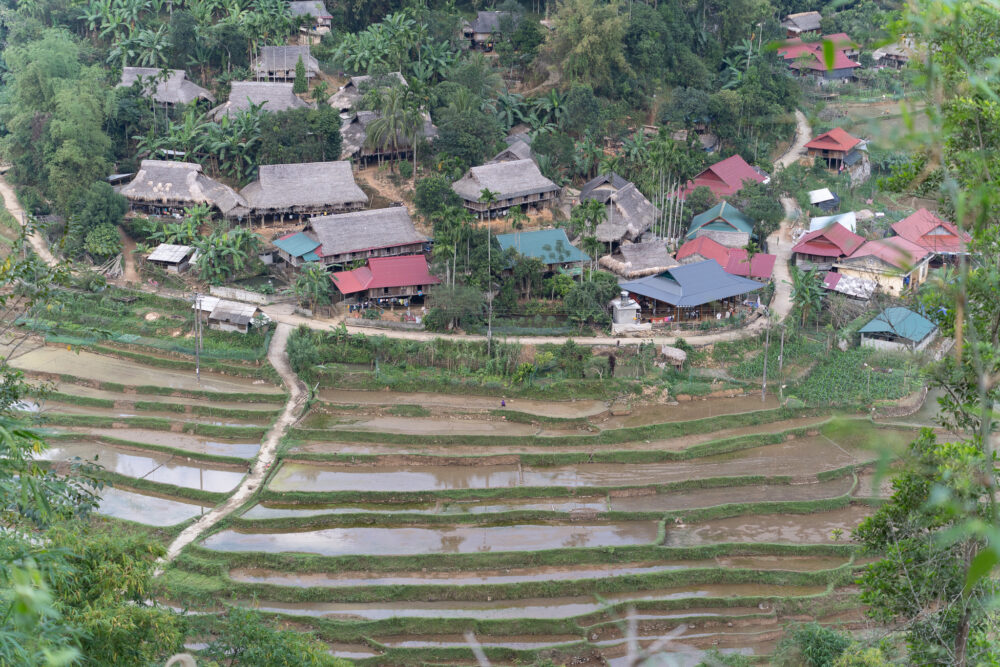
This is the most expensive homestay I suggest in this itinerary by far. But it was also one of my very favorite places I’ve ever stayed in. The treehouse bungalow is luxurious with panoramic glass windows across from the bed looking out on perfectly terraced rice fields. The host can lead you on a really cool walk/trek to some incredible viewpoints and the food was upscale and the best we ate on the North Vietnam motorbike loop. I highly recommend splurging on a stay here if you can make room in your budget.
Length of Stay: 1 night
Drive Day Three: Pu Luong to Mai Chau (60 KM)
The road is stunning the entire way. It’s a short route, so take the time to enjoy it.
Estimated drive time: 3 hours
Recommend Homestay: Mai Chau Meadows Homestay ($12.70 private room w/ breakfast)
Another lovely homestay with rice field views straight from your room. What I especially liked here is that it’s out of town. Mai Chau town is nothing to write home about. This area where the homestay is located was the prettiest in the region. Dinner is available at the property and the portions were huge.
Length of Stay: 1 night
There are a few things to do in the area. A cave hike, a waterfall, and a viewpoint. They are all marked on the map below. We arrived early enough with time to explore it all in a single day. We hit the waterfall on our way out of town the next day.
Drive Day Four: Mai Chau to Moc Chai (80 KM)
Another relatively easy drive day because you’ll be traversing major roadways. You will go over at least 2 major passes with incredible views and see some beautiful high-elevation towns along the journey.
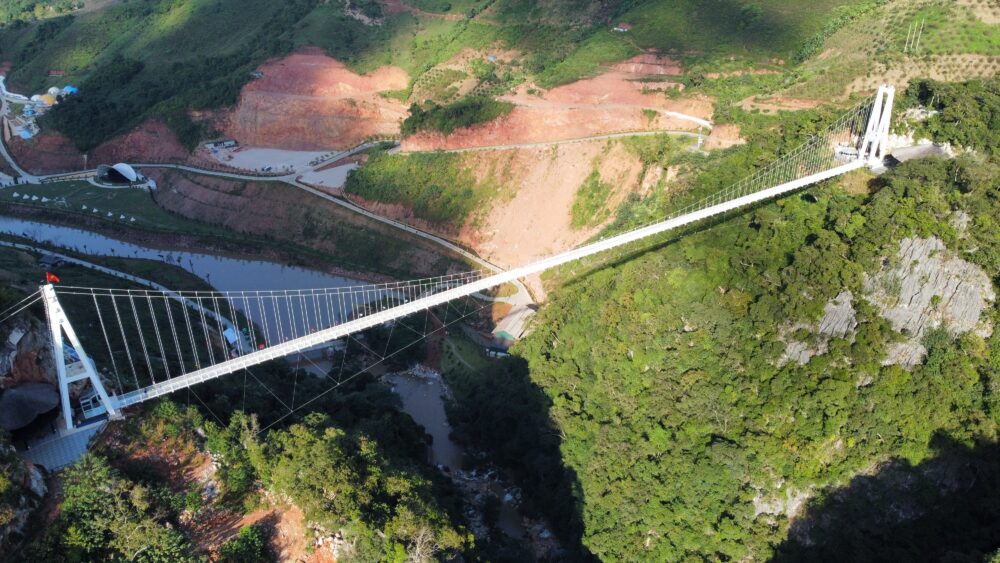
Estimated drive time: 4 hours
Recommend Homestay: The November ($20 glamping tent w/ breakfast)
I’m recommending this homestay because it was the best we could find in the region, not because it was anything incredible. The rooms are set up like bohemian camping tents and are super comfortable but the food offered at the hotel was less than desirable. Moc Chau itself was definitely not my favorite stop on the loop but it makes sense to break up long distances. If you prefer you could drive further on this day to another town and not miss anything spectacular. You will not reach Ta Xua from Mai Chau in one day, however.
Moc Chao coffee had great cheap Vietnamese coffee and mango fresh yogurt.
Length of Stay: 1 night
The only noteworthy thing to see in the area is the “dragon bridge”. This is the world’s longest glass bottom bridge. Tickets to cross it are $28 per person. This is wildly expensive and we decided to go behind the mountain and fly our drone over it for free instead. I marked both the entrance and the secret drone spot on the map for those interested in the bridge.
Drive Day Five: Moc Chai to Ta Xua National Reserve (135 KM)
10/10 drive day. In difficulty and in views. Don’t attempt to drive today, if it’s raining. Looking back this is probably my favorite drive of the loop. The entire day is small, twisting roads with panoramic views of some of Vietnam’s most impressive landscapes. While we were there some areas were under construction leaving large stretches of muddy roads and rocks. Be extra careful. Even in completed areas expect much of the route to be a road large enough for only a single car and keep an eye out for oncoming vehicles. You go through tiny nameless towns and begin to see people of various hill tribes everywhere. The scenic route we recommend (vs the route Google recommends) takes a local river ferry as well.
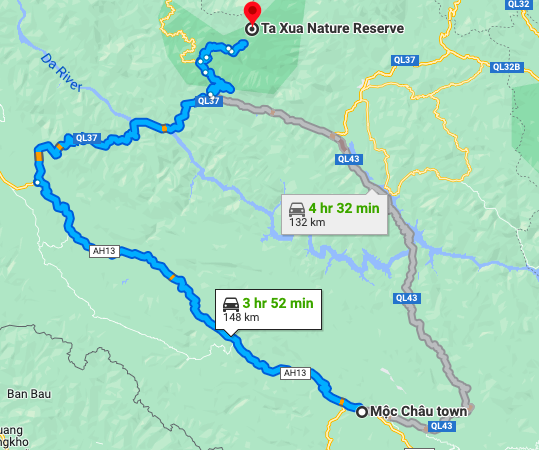
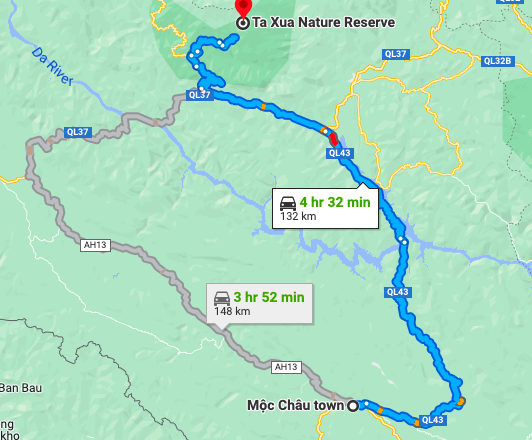
Ferry info: The small ferry runs back and forth all day, every day. It takes about 40 min for it to go and come back in case you just miss it. It costs 10k dong for a motorbike w/ two people on it. Don’t let them overcharge you. If you’re in a hurry you can also pay 25k for a motorbike with 2 people and they might have a private boat that can take you across immediately.
Once you reach Bac Yen, you’ll ascend thousands of feet on a narrow mountain road (don’t worry it’s paved) to the national reserve. Be sure to take the turn I mark on the map because the other route has a dangerously muddy road you’ll want to avoid. Once you’re above the clouds— the views are breathtaking. Vietnamese travel from all over the country to see this landscape and its alien inversion layer. It’s also at around 10,000 feet when you reach the summit. You can get some snacks from the Hmong BBQ rice and meat at the viewpoint just before you reach your homestay.
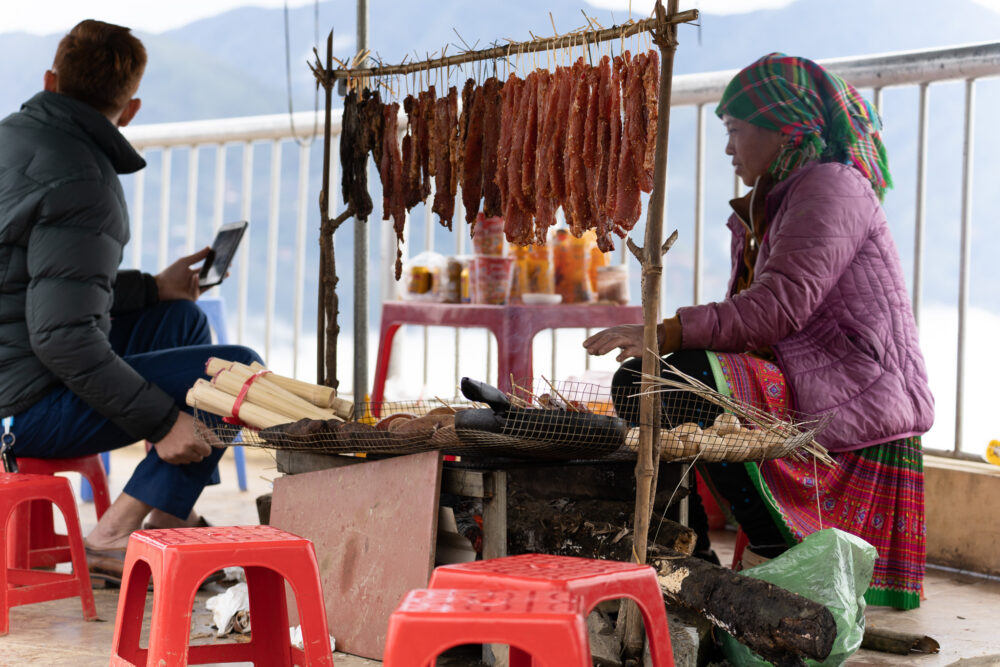
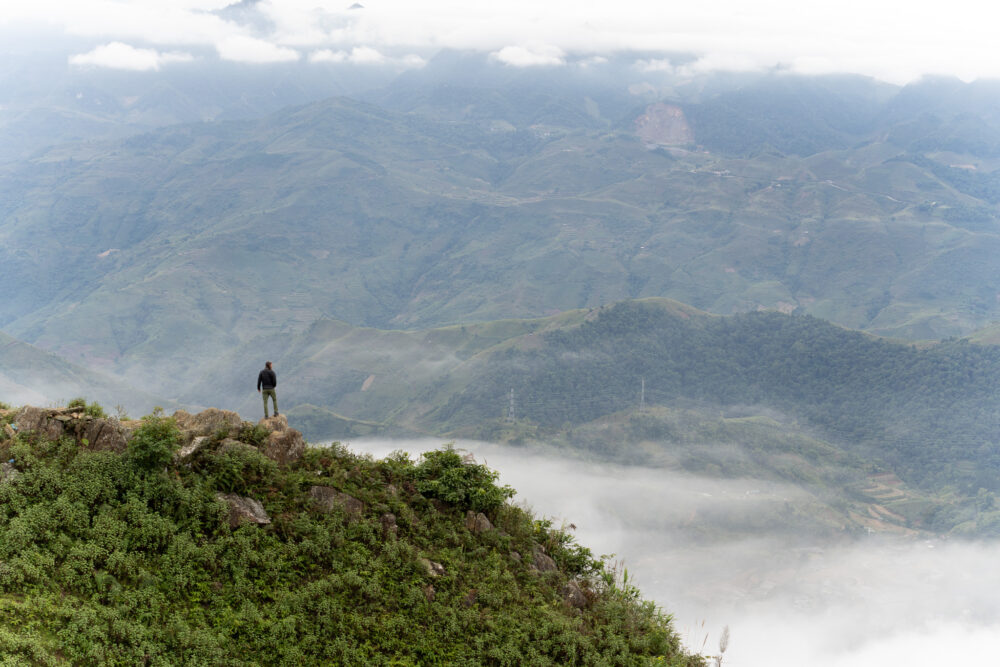
Estimated drive time: 8 hours
Recommend Homestay: Ta Xua Clouds Homestay ($33.90 private room)
Another expensive stay. But this homestay is one of the few that has big-picture windows overlooking the valley. Truly incredible views. My main complaint was that coffee, breakfast, and dinner were all an extra charge that wasn’t communicated beforehand. The hot pot was a huge amount of food though and very tasty. I recommend haggling a little and seeing if you can get it included. Dorms were also available if you would like a cheaper option.
There is no online booking available, your best bet is to just walk up or contact them via the WhatsApp number listed on their Facebook I linked above.
Length of Stay: 2 nights
Stay an extra night if you want to actually explore the park area. You can motorbike/walk to the dragon’s spine (location on map) and take epic photos and just enjoy the high-altitude trails in the area. The road to get to the spine is even more treacherous than the way up so we skipped it as we were short on time. We wished that we had had another day here instead of moving on.
Drive Day Six: Ta Xua National Reserve to Son La (100 KM)
After the last leg of the journey, this easy large two-lane highway descends from the 10,000-foot peaks of North Vietnam into the lowlands again. You’ll have to navigate the 12 KM of road you came up from Bac Yen first though.
It’s smooth sailing from there. This day is a great time to get your oil changed somewhere along the way to Son La.
Estimated drive time: 3 hours


Recommend Homestay: Galaxy Grand Hotel ($21 for a fancy private room w/ breakfast)
Not a homestay. It’s actually quite a fancy hotel, but still relatively cheap. At this point in our journey, (we had some weather issues) we could use a good night of sleep on a nice bed with a hot water guaranteed shower.
Length of Stay: 1 night
Son La is a major city and a good place to regroup with snacks and nice facilities but there isn’t much to do. I recommend a walk through Ho Chi Minh Park in the evening and grabbing a smoothie at one of the very popular nearby cafes. You can also visit the infamous Son La Prison if that interests you.
Alternative Route Day Six: For advanced drivers only. If you want to minimize backtracking at all costs and have a comfortable feel of motorbiking Vietnam at this point, you can skip going to Son La & instead head toward Nghia Lo through the most dangerous mountain pass in Vietnam. Vietnamese drive it all the time and the roads should be no worse than what you’ve seen already in Ta Xua. This will have much better views than going to Son La and will reduce your backtracking later. But it will also change your driving route on day seven. This means missing out on lakeside views and one of the prettiest mountain passes in Vietnam. In the end, we chose the route we recommend. But the map pictured below shows the alternative route for Day Six if you would like to carve your own path. The choice is yours!
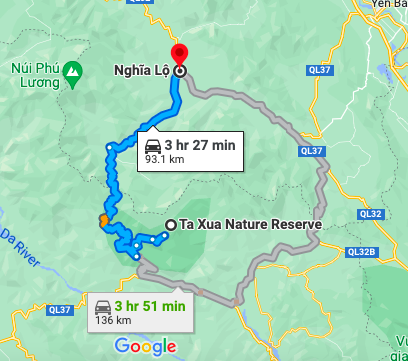
Drive Day Seven: Son La to Mu Cang Chai (190 KM)
This is another LONG and scenic drive day. One of the best. The first 40 KM are easy on large perfectly-paved roads. The next 80 KM are much smaller and windier. This means slower. Be sure to leave early today to allow for photos along the way.
The final 40 KM of the road will all have to back-tracked later (this is why I have suggested the alternative Day 6 route above) but it’s so scenic you won’t mind. This region is one of my favorite in Vietnam. But you can see tourism development coming quickly. It might be the new Sa Pa in 10 years.
Visa Run! Son La is the closest you’ll get on this North Vietnam motorbike loop to the Laos border. If you want to extend your visa in Vietnam, I recommend taking a detour here to the Sop Hun border crossing. Just be sure to apply for your next Vietnam visa online at the official website.
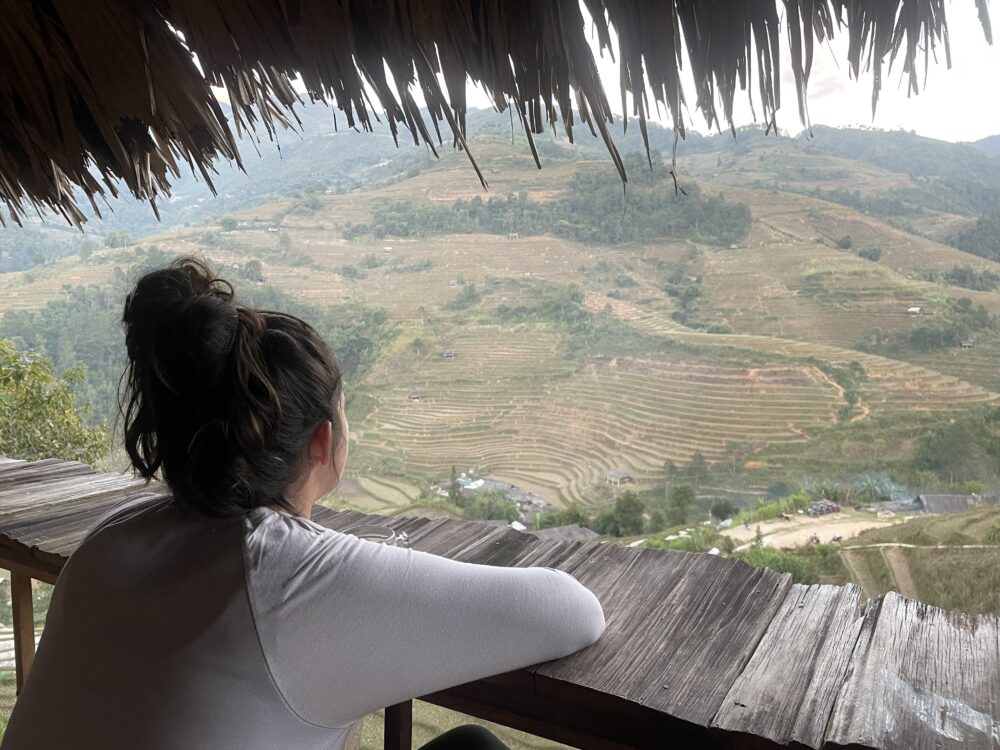

Estimated drive time: 8 hours
Recommend Homestay: Hello Mu Cang Chai ($20 private hut w/ a view and breakfast)
If I had to pick one favorite Hmong homestay in Vietnam it would be this one. The hosts are Hmong and spent the evening drinking homemade rice wine with us. The food was a massive spread & one of our favorite meals in Vietnam. Dinner was super cheap as well. Especially considering the portions and rice wine. The bungalow was spectacular. Super warm even in the chilly winter months and directly facing the BEST terraced rice fields in the country. Seriously, this place is super underrated and if you stay here you won’t regret it.
The directions on Google Maps are slightly wrong, but fortunately, there are wooden signs along the way to guide you. Just follow them. I marked the main road turn-off on the full North Vietnam Motorbike Loop map below.
Length of Stay: 2 Nights
Mu Cang Chai deserves more than a single day. Odds are, you’ll arrive late in the evening and spend most of the afternoon at your homestay. But the next morning you should set out to Lao Chai just 20-30km away for the most impressive rice terraces in Vietnam. And just in general, some great views of the area. Look for the blue sign marker and I’ve marked the location of the Lao Chai Viewpoint on the map below. We spent an entire day driving around and taking photos of the different rice fields and shopping for traditional H’mong-made fabric at the market.
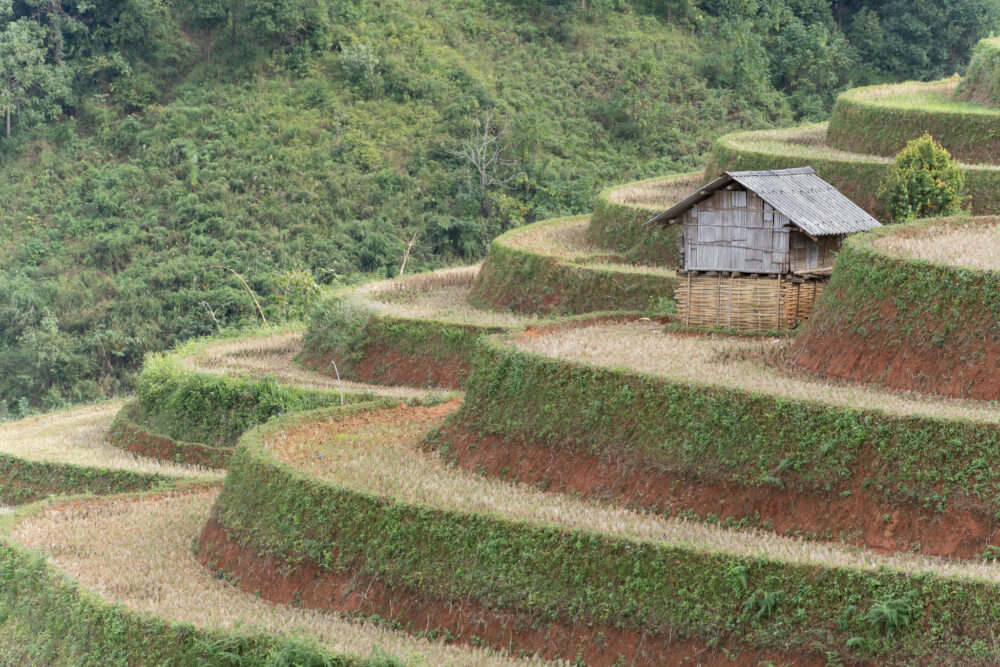
SHORT ON TIME? BAD WEATHER? SKIP SA PA. This might seem blasphemous but Sa Pa is the most touristy destination on this list. It’s also the highest in elevation, coldest, and most sensitive to fog. This means depending on the time of year and you’re reasons for visiting, it might be worth skipping altogether. We did. (I’ve also visited it before). In reality, the other places you’ll stay on this journey are better versions of Sa Pa. If you do decide to cut it out skip drive day 8 (below) and head straight to Cinnamon Ecolodge from Mu Cang Chai.
Drive Day Eight: Mu Cang Chau to Sa Pa (156 KM)
We skipped this portion of the drive so I don’t have an accurate drive time or homestay recommendation.
Length of Stay: 2 nights minimum
If you do choose to visit Sa Pa, you must spend at least one night in a local homestay after a full day of trekking. This means that you need at least 2 nights here. Sa Pa town itself is of little interest. It’s full of cheesy attractions and very overdeveloped.
Drive Day Nine: Sa Pa to Cinnamon Ecolodge (130 KM)
No matter what, you’re headed to Cinnamon Ecolodge because it’s about halfway from Sa Pa to Ha Giang, Lao Cai to Ha Giang, or really Ha Giang from anywhere.
I can’t speak about the roads from Sa Pa other than they look to be main roads and you should have no problems. You will want to avoid the big yellow route on Google Maps as much as possible to avoid police speed traps. I recommend taking this route pictured on the Map below instead. If you choose to visit Sa Pa that is.
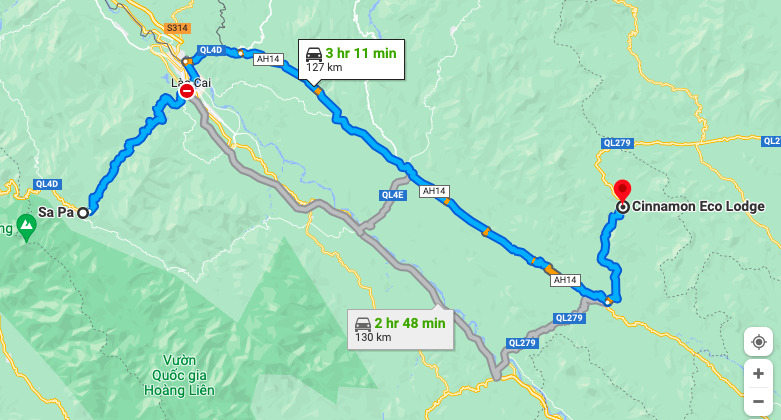
Estimated drive time Sa Pa to Cinnamon Ecolodge: Roughly 5-6 Hours
Estimated drive time Mu Cang Chai to Cinnamon Ecolodge: 7 hours
If you are coming from Mu Cang Chai like us— first you’ll backtrack the 40 KM you drove already, then on the middle 40 KM expect more potholes than actual road. You’ll snake up and down through the mountains for quite a long time. It makes for tough driving. But the last stretch into town is on the main road. You should have no problems if you leave early.
Recommend Homestay: Cinnamon Ecolodge ($21 Private Room w/ breakfast)
This is the destination. Beautiful cinnamon farm in the middle of nowhere where you can rest, warm up by a fire, and enjoy an awesome home-cooked meal with the family who lives here. And more rice wine of course. I loved this place. We also got upgraded to one of their fancy bungalow rooms because we had booked ahead and one was available.
Length of Stay: 1 night
Drive Day Ten: Cinnamon Ecolodge to Ha Giang (105 KM)
An easy drive. Main roads for most of the journey. The only hazard you’ll face is having to avoid all the huge trucks that constantly pass at inopportune times. This is also an area where police often set up checkpoints looking for motorcyclists heading to the Ha Giang Loop because it’s so well known for motorbiking.


Estimated drive time: 3 hours
Recommend Homestay: Be’s Homestay ($11 for two dorm beds + breakfast)
You MUST stay here. Seriously, I might have said it one other time in this post but THIS is the best homestay in Vietnam.
Not because of the scenery though — it’s a simple home with a very clean comfortable dorm/private rooms in the residential (better) part of the city. It’s the best because of the hosts. Thao and Danny are a Vietnamese and Spanish couple that give and give. They can set you up completely for the Ha Giang Loop. In fact, they give each guest a color-coded and personalized map of what they want on the infamous Ha Giang loop. If you want a Ha Giang Loop tour or Ha Giang Loop Easy Rider they can set you up with the best version. For us, they showed mapped how to venture off-the-beaten-path and on an itinerary that exemplified what the Ha Giang motorbike loop was before all the group tours and mass tourism changed the area.
They also showed us excellent local spots to eat in Ha Giang, what to do in Ha Giang, made homemade bread for breakfast, pizza for dinner (really truly good pizza), and treated us like family even though we were complete strangers.
I’m not going to give away all their Ha Giang motorbike loop secrets. Instead, you have to stay with them. It’s the only way to preserve the parts of the loop that still remain authentic. And believe me, you won’t regret it.
Length of Stay: 2 nights
Ha Giang is actually a cool little town. I was expecting it to be very touristic and difficult to find real local food — but it was actually quite nice. You should stay an extra day to rest up for the roads ahead even if you don’t want to see the sights mapped below in Ha Giang. You need time to prepare for your route.
Quick Ha Giang Loop Info
Since the Ha Giang Loop in Yen Minh province is one of the most popular routes for backpackers motorbiking Vietnam, it can be quite crowded. Some people hire a driver- this is known as a Ha Giang Loop Easy Rider. Other people join Ha Giang motorbike tours where they drive in groups of 20+ people.

Obviously, this is not how we recommend doing the Ha Giang loop.
The homestays along this portion of your journey will become more like communal dorms where you sleep on floor mats and are given piles of blankets.
Drive Day Eleven: Ha Giang Motorbike Loop Day One
Day one is an incredible introduction to the loop. If you happen to have a sunny day or a day with high clouds you’ll enjoy panoramic views of the limestone karst landscape. We thought after driving in Vietnam for nearly 2 weeks now that we would have seen landscapes just as impressive— but we were wrong. Ha Giang is truly all its cracked up to be. Spectacular.
Expect a lot of high passes, slow winding roads, and maybe a little construction that can leave the road pretty choppy. If you have the misfortune of driving on an overcast day with low clouds you might end up driving through them which can be a very damp and dreary ride. Dangerous too. Drive slowly when visibility is low.
On this day you’ll pass Heaven’s Gate, otherwise known as Quan Ba Pass, and many other of the most beautiful parts of Ha Giang loop as you drive through Yen Minh province.
Estimated drive time: 8 hours
Every single day on the loop is a long drive day. If you plan to do it in 3-4 days that is. I don’t recommend trying to complete this loop in less than 4 days. I highly recommend leaving a little LATER than usual on this first day so you don’t end up caught in the crowds of Ha Giang easy rider tours.
Recommend Homestay: ???? This is the one I can’t give away. You’ll have to ask Danny.
Most people on the Ha Giang loop will stay somewhere along the Dong Van Plateau on day one. This is not recommended because Dong Van kinda sucks. Our secret stop is actually before Dong Van.
Length of Stay: 1 night
Drive Day Twelve: Ha Giang Loop Day Two
This was the easiest drive day as far as roads go. Another great day with even better scenery as you continue through Dong Van karst plateau park. Be sure to stop and grab a coffee or hot cocoa somewhere in Dong Van. It’s really impossible to define exactly what the most beautiful parts of Ha Giang Loop really are. It’s just all incredible if you’re blessed with a sunny enough day to see it.
Estimated drive time: 8 hours
Today, you’ll head up to the northernmost point in Vietnam. The Lung Cu flag tower. I’ve marked a few other points of interest on the full North Vietnam Motorbike Loop Map below as well. If it’s super fogged in when you reach the turnoff point I marked as *important*, I recommend skipping the Lung Cu flag tower and everything north as you’re not going to see anything anyways. Instead, continue on to Meo Vac, Vietnam.

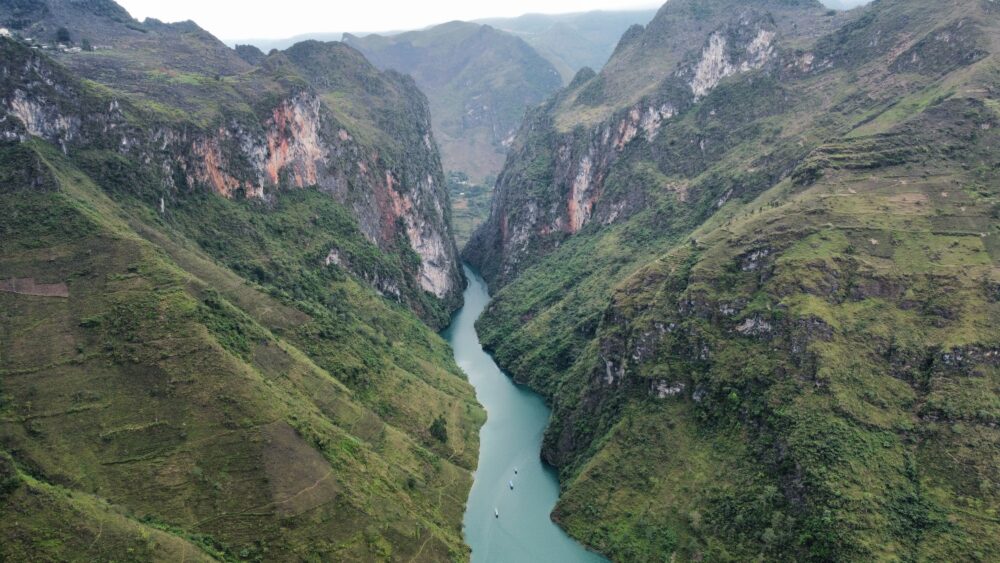
Recommend Homestay: Meo Vac, Vietnam
This isn’t a homestay, but a town. Danny recommended staying in Pa Vi because most Ha Giang Loop riders stay in Meo Vac. It was the only suggestion I disagreed with. Pa Vi was actually constructed 3 years ago as a literal town for tourists. It’s a small enclave of nothing but homestays and while they are super comfortable (stay in Little Yens if you do go) I would have preferred Meo Vac which appeared to be a real Vietnamese town and not as changed by tourism as Dong Van was.
Length of Stay: 1 night
You *can* drive down and float on the stunning blue river before you leave here. Well, sometimes blue. It takes about an hour for the boat ride in total and you’ll have to wind down some very pot-holed roads to get there. I don’t recommend it. Not because of the roads but because of the experience. The river is far prettier from up high and the $5 ticket price is very expensive for Vietnam. It was definitely just a photo op for the many Vietnamese on board our boat. You’ll float out to the cliff side take photos for 20-min and then they take you to a small coffee shop that you have to pay to enter. Seemed to be a bit of a tourist trap to me. My advice- skip it.
River Boat info: It’s open from 7 AM – 6:30 PM, although to me, after dark seems absolutely pointless. It’s crowded in the morning so if you can go between 4 PM – 5 PM that is the sweet spot.
Drive Day Thirteen: Ha Giang Loop Day Three
This day is either a nightmare or one of the best, depending on the kind of person you are. It’s also currently the day most people crash their bikes. This is because a huge portion of the route is currently under construction (Jan 2023).


Estimated drive time: 6 hours for 75KM
The middle 40 KM or so is a muddy, rutted, sloppy nightmare if it has rained recently. Hopefully, this will change as construction finishes but who knows when that will be. Take your time and leave early. This is why good tires are so important for the Ha Giang motorbike loop.
Recommend Homestay: Du Gia Panorama ($17 for the largest glass wall room & breakfast)
One of my favorite homestays on the Ha Giang Loop because the rooms all have incredible views of the Dong Van karst plateau valley. Food here is also quite good. Family-style meals by the fire and a very nice host. Lots of free rice wine as well.
Length of Stay: 2 nights
This happens to be one of the most scenic areas on the Ha Giang Loop. I’ve marked a few viewpoints, a good coffee shop with a view, some ruins, a lunch spot, and a little village to explore on the North Vietnam Motorbike Loop map. I would take an extra day to see it all and rest after finishing a challenging stretch of Vietnamese roads.
WHAT WE DID: With time running out on our visa and bad weather predicted ahead, we opted to spend drive day 14 heading back to Ha Giang or in other words, finishing the traditional Ha Giang Loop instead of continuing on to Bao Lac and Cao Bang. This is just because we were short and time and the road you have to backtrack is the mud one. With severe rains, it just wasn’t safe to backtrack the treacherous route we came. You can’t go around the other way (shown on the maps I include below) because the roads are even worse. When we finish the loop again in 2023, I will update this post.
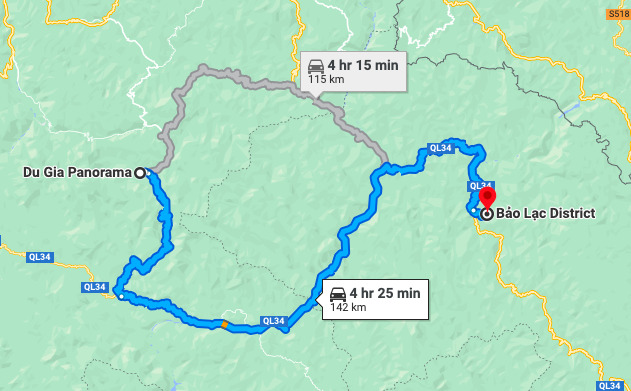
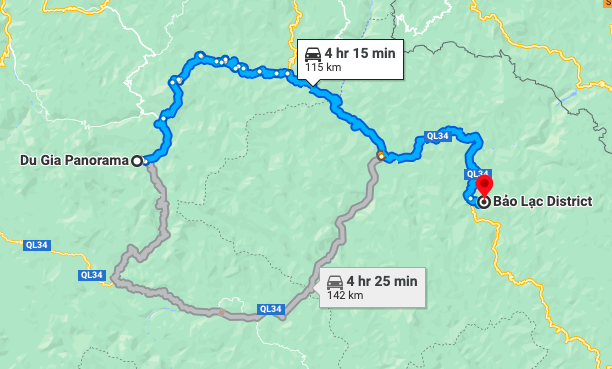
Drive Day Fourteen: Du Gia to Bao Lac (102 KM)
This is a rough one. Mostly due to construction so maybe by the time you reach it the road won’t be muddy and non-existent. Just prepare yourself.
Optional Detour: There is this really cool bamboo ferry just off course called the Mang Tre Bamboo Ferry. It’s 100% worth the detour IF you are an experienced rider and not riding on a small scooter. I also wouldn’t recommend having two people on one motorcycle. It costs $3 to cross so make sure you have cash.




Estimated drive time: Roughly 6-7 hours
Recommend Homestay: Bao Lac Homestay & Hostel ($16 double room)
Getting here was again…kinda tricky just due to the lack of signs. But the food here was great, you got to eat with the family, the views were incredible, and the rooms were comfortable.
Length of Stay: 1 night
Drive Day Fifteen: Bao Lac to Cao Bang (105 KM)
This is the squiggly road day and my personal favorite on this whole list. You’ll drive multiple squiggly roads but the most impressive is Me Pja Pass. You have to hike about 1 KM to the viewpoint from the cafe at the top of the hill so watch for the sign.
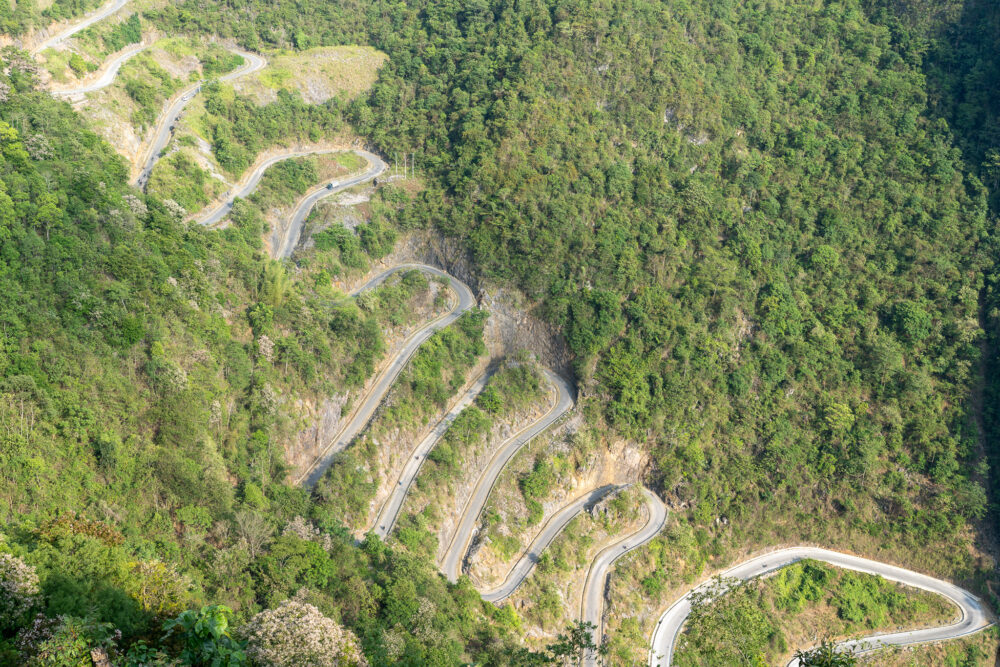
Estimated drive time: 5 hours
You can take all day with this one. There are loads of great detours that are all paved as you pick your path toward Cao Bang.
Recommend Homestay: DH Homestay Cao Bang ($10 double room)
The woman who runs this homestay is so kind! It’s relatively new so it doesn’t have a ton of reviews yet but I can assure you that it was super clean, had protected motorcycle parking, and was within walking distance to all the good food and the scenic river in Cao Bang.
Length of Stay: 1 night


Drive Day Sixteen: Cao Bang to Bang Gioc (150 KM)
Most of the reason to visit Cao Bang is the Bang Gioc waterfalls. They sit on the border with China and are best viewed early in the morning which is why I recommend sleeping one night in Bang Gioc.
Short on time? Combine days 16 + 17. If you don’t care when you see the waterfall or find yourself there early the day before… you can combine this drive day with day 16. It will just turn a short drive day into a long one.
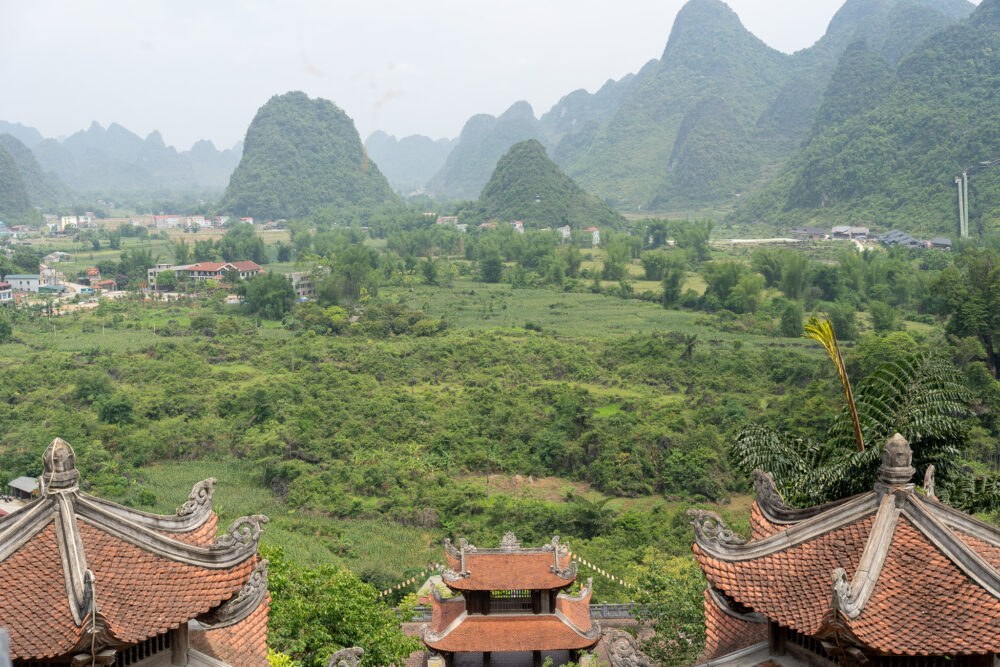
Estimated drive time: 4 Hours
This is one of the easiest ride days in the north because the entire way is paved. Take your time and take lots of photos.
Recommend Homestay: Lans Homestay Cao Bang ($14 double room)
Don’t let the name fool you this homestay is not in Cao Bang. It’s very near the waterfalls and nestled in nature by a river. Very scenic and beautiful. Highly recommend. Just keep in mind that some of the rooms are better than others here.
Length of Stay: 1 night
Don’t forget about Angel Mountain on your way up to the waterfalls also!
Drive Day Seventeen: Bang Gioc to Cao Bang (150 KM)
Take the same route back the way you came to Cao Bang. Or pick a new one.
Still short on time?? This is another great bail-out point. There are lots of buses from Cao Bang to Hanoi and not a ton to see between the two cities. I recommend throwing your bike (and yourself) on a bus if you’re cutting your visa close at this point. Or are tired of long days on a hard motorbike seat. The only thing you’ll miss is a large lake. Not a trip highlight for most.
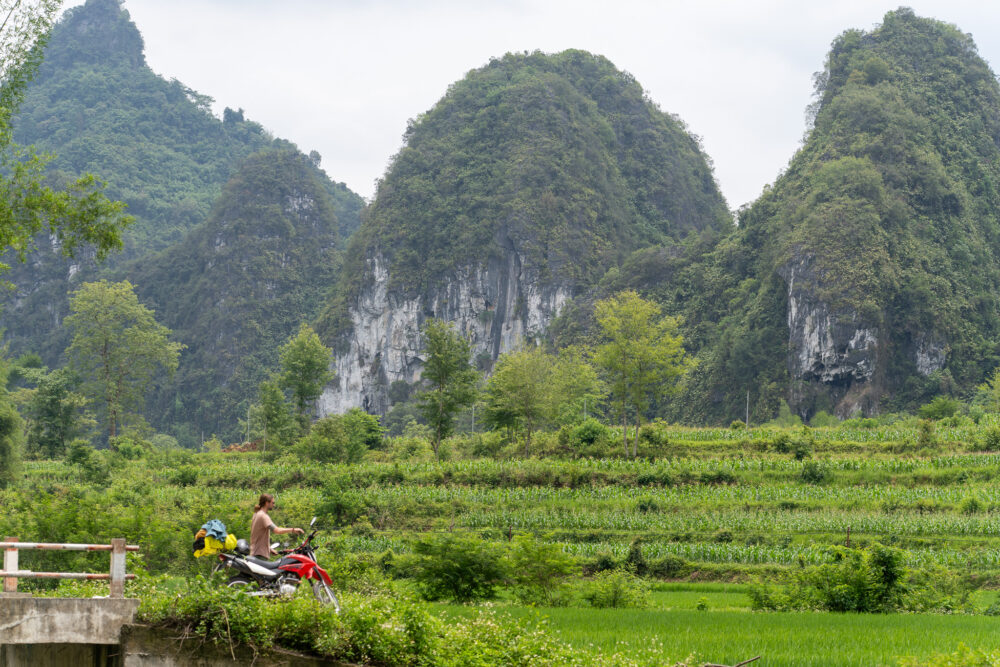
Estimated drive time: 2.5 hours
Recommend Homestay: DH Homestay Cao Bang ($10 double room)
The woman who runs this homestay is so kind! It’s relatively new so it doesn’t have a ton of reviews yet but I can assure you that it was super clean, had protected motorcycle parking, and was within walking distance to all the good food and the scenic river in Cao Bang.
Length of Stay: 1 night
Have a longer visa? If you’ve planned ahead and popped over to Laos already on a visa run I recommend you head out to Cat Ba (Ha Long Bay Area) for some beach time before continuing south down the country. If you don’t have to head back to Hanoi right away this is definitely a better route.
Drive Day Eighteen: Cao Bang to Ba Be Lake (125 KM)
I have not yet driven this route but it was suggested to me. If you’re headed back to Hanoi and don’t fancy taking a bus try this instead.
Personally, I would recommend going back via Ha Long rather than cutting through the center to Ba Be if you plan on driving. Otherwise, you can very easily get a bus ticket and ship your motorcycle on the bus from Cao Bang to Hanoi.
Estimated drive time: 4-5 hours
Drive Day Nineteen: Ba Be Lake to Thai Nguyen (135 KM)
I have not yet driven this route but it was suggested to me. If you’re headed back to Hanoi and don’t fancy taking a bus try this instead.
Estimated drive time: 5 hours
If you’re feeling up to the drive you can conceivably combine days 19 + 20 to just get you back to Hanoi as soon as possible. It’s a really long haul and you’ll probably have to take some major roads to save time but just remember the police rules and you’ll be fine.
Drive Day Twenty: Thai Nguyen to Hanoi (85 KM)
I have driven this roadway and it’s a major highway. Be careful with trucks and other traffic.
Estimated drive time: 4 hours
Recommended Hostel: Tobalo Hostel ($6 dorm beds)
This is where we left our stuff in Hanoi and found them to be friendly and helpful rather than pushy with tours. Also, they have a great laundry service for cheap that you will definitely need to take advantage of after this giant North Vietnam motorbike loop.
Recommended Guesthouse: Khai Homestay ($16 for Double Room)
This homestay went above and beyond in Hanoi. The owner gave me tons of food recs and let me leave a whole slew of bags in their closet for 2 weeks with not a single extra charge. He also had bike parking and lots of free fruit and tea. If you’re looking for a step up from the hostel life with a great host and EXCELLENT rooms this is the place for you. Also, the A/C was spectacular.
Map of our Epic North Vietnam Motorbike Loop
Without further ado, here’s the master map of all the destinations I’ve mentioned in this guide and the one giant circular route that connects them all into one North Vietnam motorbike loop.
If you find the map confusing with the driving directions, click the map, and shut off layers while viewing in a new Google Maps window.
Smaller Alternative Motorbike Routes for Those With Less Time (or a sore butt)
Here are maps for two smaller routes that you could try in Northern Vietnam if this large North Vietnam motorbike loop seems too daunting.
Ninh Binh – Mai Chau Loop (Map)
The limestone + rice field loop. This is a very easy motorbike route for all skill levels and could be a good test before you head way up north. You won’t see the MOST impressive sights (in my opinion) but you will see some really incredible landscapes.
Classic Ha Giang Loop Map w/ Cao Bang Extension
Most backpackers do the Ha Giang Loop, but if you’re already up there it makes sense to head from Ha Giang to Cao Bang. You get the zig-zag road, the biggest waterfall in Vietnam, and see a town relatively untouched by mass tourism in the North.
How much should you expect to spend on this North Vietnam motorbike loop?
Finally, let’s talk money. Because while it isn’t the most important thing you might be a little curious. Here’s a breakdown of all our costs during the 3-week journey.
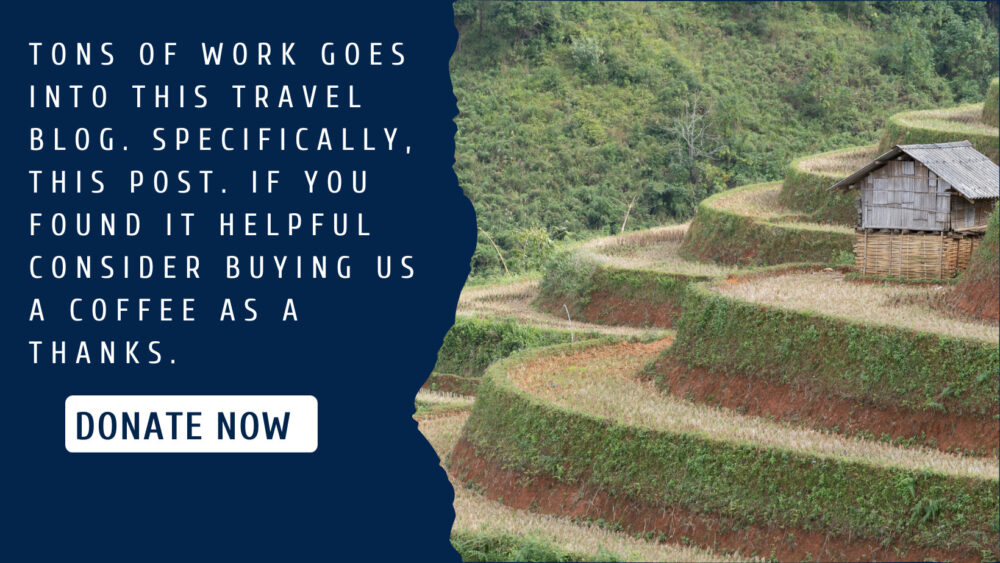
Motorbike Rental Per Day: 200k or $8.50
Accommodation per night: $18 (averaged)
Food per day: $15
Gas total: $46.59
Breakdowns total: $22.17
Maintenance total: $10.66
Average per day for two people: $42.76 per day
Total spent over 26 days for two people: $1,111.96
This can be done for far cheaper too! We were often tired at the end of a long ride and didn’t deprive ourselves of any beer, food, or snacks along the way. Considering the Ha Giang Loop cost alone for those doing an easy rider tour can be upwards of $250 for 3 days…this is a deal!
Let me know in the comments or shoot me a message on Instagram if you have any more questions I can answer to help you plan an epic North Vietnam Motorbike loop!
Save This North Vietnam Motorbike Loop For Later!!
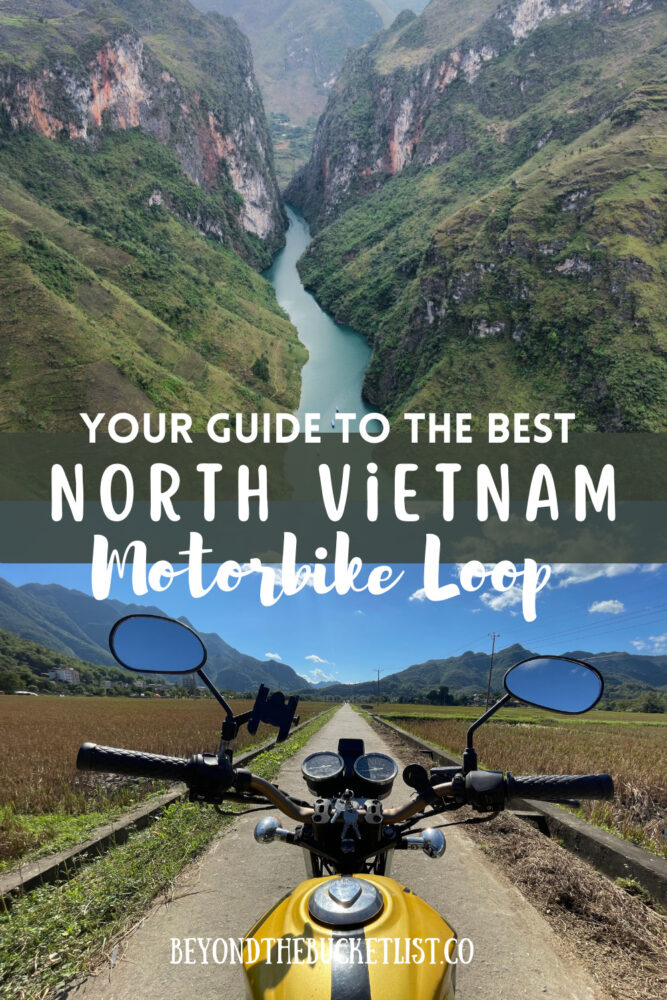

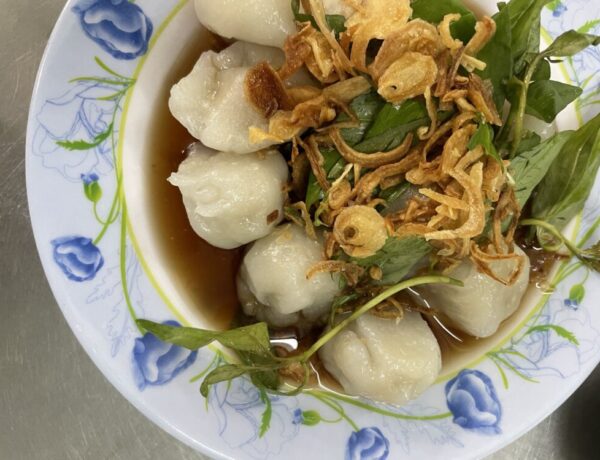
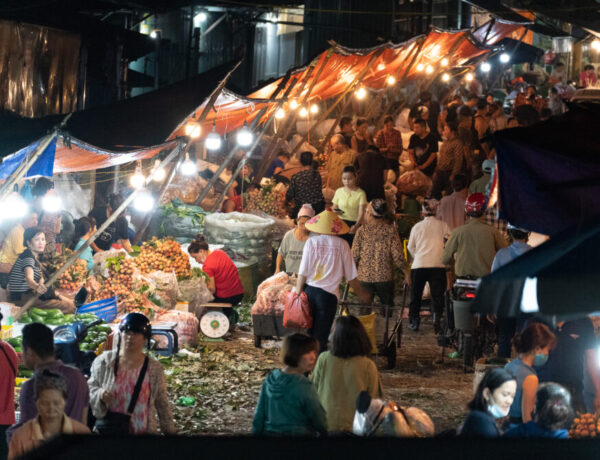
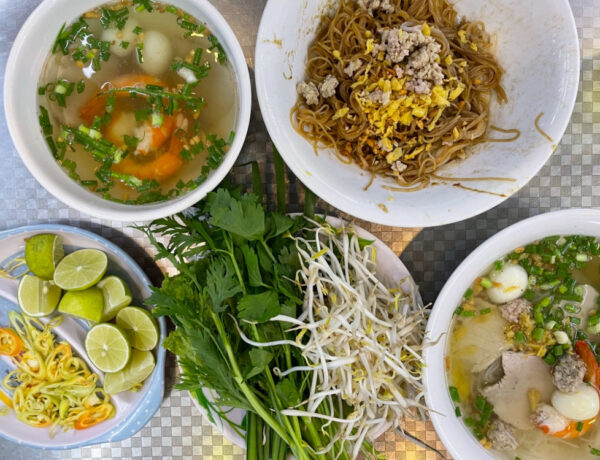


6 Comments
Ivan Andelovic
October 2, 2023 at 3:46 amAwesome info, thanks Geena! A detailed question: we (a group of 4, me + my gf on 1 bike, and two other friends on separate bikes) are going to visit Vietnam upcoming January/February. From 10 January till 30th January, we thought about going pretty much the whole North (Hanoi start and then going to Sapa, Ha Giang, close to the border of China, then to Ha Long Bay and go back to Hanoi) – so that would be 20 days. Do you have any recommendations on how to handle that on our own (we are experienced SE Asia travelers and know how to ride bikes there) – our main problem is how to handle the backpacks – I’m especially asking for me+my gf as we are going to be on 1 bike haha, while two other friends will ride their own bike and I know they can fit a backpack on the backside. Any solutions for 2 backpacks or if we fit everything in one, what to do with the other backpack these 20 days – maybe possible to leave it in the rental motorbike house in Hanoi? And will even 1 backpack fit with two of us on the bike haha? And is maybe an option to book a part of these 20 days (let’s say 7) with an agency, and then continue on our own? Thanks once again for taking the time to read, think and hopefully reply 🙂
admin
November 11, 2023 at 12:23 pmYes you can totally fit one large-ish backpack on the standard motorcycles in Vietnam with two people. Motorcycle though, not scooter. The company I listed in this post has plenty to rent. This is what I did with my husband. We left behind all the rest of our stuff for three weeks at a hostel/guesthouse in Hanoi. I think most of them will do it, but I really recommend Khai Homestay. They have safe storage and didn’t charge us a dime. As for the agency… I think it’s totally unnecessary. If you have any scooter/moto experience you can do it on your own no problem. I HIGHLY recommend taking the route toward Pu Luong and slowly working your way up toward Sapa like I suggest in this post because it gives you a chance to get used to the roads. Conditions are overall good and weather should be wonderful then. Get a SIM card and download Maps.me and you’ll be totally fine. You’re never too far from a guesthouse or bike repair shop. Have so much fun!!!
Natasa
April 29, 2024 at 9:55 amThank you for the detailed itinerary. We closely followed some suggestions and also made our own route. Quick update related to Alternative Route Day Six: the mountain pass where you skip Son La and go into direction of Nghira Lo is newly paved. While still incredibly steep, I would say it isn’t really dangerous anymore. We did it in drizzle and fog (we had bad weather in Ta Xua) and we also rested once to cool down the brakes a bit.
Ash
August 1, 2024 at 4:05 amHey, thanks for all of the amazing in depth info. Do you have any recommendations of bike rental places in Hanoi? Somewhere that they are happy for the longer journey and three week itinerary – we are also going to fit two people on one bike 🙂
Jane Edwards
March 11, 2025 at 3:41 amI couldn’t find your recommended bike rental in Hanoi. Could you please let me know who you used.
chen
March 13, 2025 at 9:04 amThanks for the detailed information
Is the route suitable for a 4wd vehicle